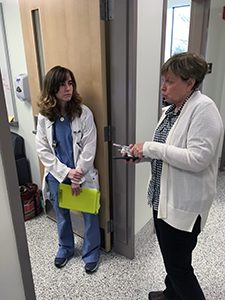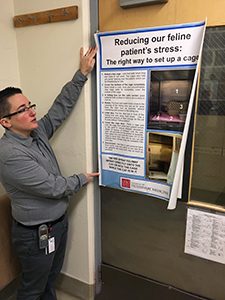
It has been a very busy first quarter here at CattleDog Publishing. First, Sarah Flowers (Marketing & Online Certifications Coordinator for CattleDog Publishing) and I had a wonderful time at the North American Veterinary Conference in Orlando, Florida. Just recently, Debbie Gass and I returned from a wonderful week at the Midwest Veterinary Conference in Columbus, Ohio, where I presented 6 hours of Continuing Education (CE) lectures addressing the topics of stress reduction in patients during emergency care, feline handling, and the impact of bite/near-bite job stress. Debbie staffed the CattleDog Publishing booth most of the day, especially while I was networking with other professionals. The day before the conference started, Debbie and I visited the Ohio State College of Veterinary Medicine Small Animal Clinic. Dr. Yin had visited the college a few years ago and had filmed some Low Stress Handling® segments at the OSU College of Veterinary Medicine Clinic.
When Debbie and I arrived at the Veterinary College Clinic I was quite impressed. The waiting area was large and had many details that addressed reducing patient anxiety while keeping admission easy for the owner. Some of these details include:
- The seating area was designed to reduce dog to dog interaction
- Automatic doors that open up to a circular drive
- Separate feline waiting areas with opaque glass
- Private corridor for aggressive dogs to avoid all stimuli.
Dr. Susan Barrett, head of the community practice, showed me around the newly renovated (and still under construction) small animal clinic and allowed me to observe patient visits. She and Dr. Meghan Herron were instrumental in the design of the clinic, especially the waiting area. The canine and feline hospitalization wards have been enhanced and expanded to incorporate new housing and critical care beds for both species. Overall, the Ohio State University Veterinary Medicine Clinic is one of many clinics around the world that are doing everything they can to provide patients, staff, and clients with the best Low Stress Handling® environment possible. I would like to offer a big thank you to the behavior and Community Practice staff for allowing me to spend time visiting their newly renovated facility.
What I found most impressive, is that all veterinary students have a two-week rotation in the Veterinary Medical Clinic. Every day, patient behavior is part of the clinical assessment and delivery of care in the safest, least stressful manner is discussed before treatment. In short, patient behavior is part of the health care plan. The goal is not about addressing behavior problems, but rather it is about the student being able to observe and discover ways to educate clients on the best options to enhance patient behavior for care. This baseline education allows these students to be prepared for going into practice. Currently, many veterinary practices report that an average of 1 in 10 patients is aggressive – these students are being prepared to assess, address, and administer the least stressful and appropriate care for all feline and canine patients.
Ohio State University and Virginia-Maryland University are two of the veterinary colleges that have taken a lead to set standards of care using positive veterinary visit practices. They are certified in Low Stress Handling® which provides the specific techniques and foundation of behavior education to make the best plan for care. My hope is that all colleges of veterinary medicine will do the same.
Preparing students to know how to manage and reduce the aggression of patients they are caring for is, unfortunately, not the norm or the standard of veterinary education. Adding education in positive veterinary care does not need to be difficult or complicated. At least 2 veterinary colleges have taken the lead and I thank them dearly for that.
So where is your Alma Mater at with educating about safe and Low Stress Handling® of animals in care? If you don’t already know, ask them. Stress is common in both companion animal and production animal care and reducing this stress is important for both the animals’ welfare and for staff safety. To not prepare our future workforce is a shortfall that cannot be addressed through experience only.
For Further Reading
- Low Stress Handling® – From the Veterinary Technician’s Perspective
- What is the Low Stress Handling® Certification
- The Future of the Low Stress Handling® Certification
- Ohio State University – College of Veterinary Medicine




